2015 DODGE CHALLENGER SRT brakes
[x] Cancel search: brakesPage 390 of 575

WARNING!(Continued)
efficiency beyond that afforded by the condition of
the vehicle brakes and tires or the traction afforded.
• The Anti-Lock Brake System (ABS) cannot prevent
collisions, including those resulting from excessive
speed in turns, following another vehicle too
closely, or hydroplaning.
• The capabilities of an Anti-Lock Brake System
(ABS) equipped vehicle must never be exploited in
a reckless or dangerous manner, that could jeopar-
dize the user’s safety or the safety of others.
All vehicle wheels and tires must be the same size and
type and tires must be properly inflated to produce
accurate signals for the computer.
Anti-Lock Brake Warning Light
The “Anti-Lock Brake System (ABS) Warning
Light” monitors the Anti-Lock Brake System. The
light will come on when the ignition switch is turned to
the ON position and may stay on for as long as four
seconds.
If the “ABS Warning Light” remains on or comes on
while driving, it indicates that the anti-lock portion of the
brake system is not functioning and that service is
required. However, the conventional brake system will
continue to operate normally if the “Brake Warning
Light” is not on.
If the “ABS Warning Light” is on, the brake system
should be serviced as soon as possible to restore the
benefits of anti-lock brakes. If the “ABS Warning Light”
388 STARTING AND OPERATING
Page 391 of 575

does not come on when the ignition switch is turned to
the ON position, have the bulb repaired as soon as
possible.
If both the “Brake Warning Light” and the “ABS Warning
Light” remain on, the ABS and EBD systems are not
functioning. Immediate repair to the ABS system is
required.
Traction Control System (TCS)
This system monitors the amount of wheel spin of each
driven wheel. If wheel spin is detected, brake pressure is
applied to the slipping wheel(s) and engine power is
reduced to provide enhanced acceleration and stability.
A feature of the TCS system, Brake Limited Differential
(BLD), controls the wheel spin across a driven axle. If one
wheel on a driven axle is spinning faster than the other,
the system will apply the brake of the spinning wheel.
This will allow more engine torque to be applied to the
wheel that is not spinning. This feature remains activeeven if TCS and ESC are in the “Partial Off” or “Full Off”
modes. Refer to “Electronic Stability Control (ESC)” in
this section for more information.
Brake Assist System (BAS)
This system complements the ABS by optimizing the
vehicle braking capability during emergency braking
maneuvers. This system detects an emergency braking
situation by sensing the rate and amount of brake appli-
cation and then applies optimum pressure to the brakes.
This can help reduce braking distances.
Applying the brakes very quickly results in the best BAS
assistance. To receive the benefits of this system, you
must apply continuous brake pedal pressure during the
stopping sequence. Do not reduce brake pedal pressure
unless braking is no longer desired. Once the brake pedal
is released, the BAS is deactivated.
5
STARTING AND OPERATING 389
Page 436 of 575
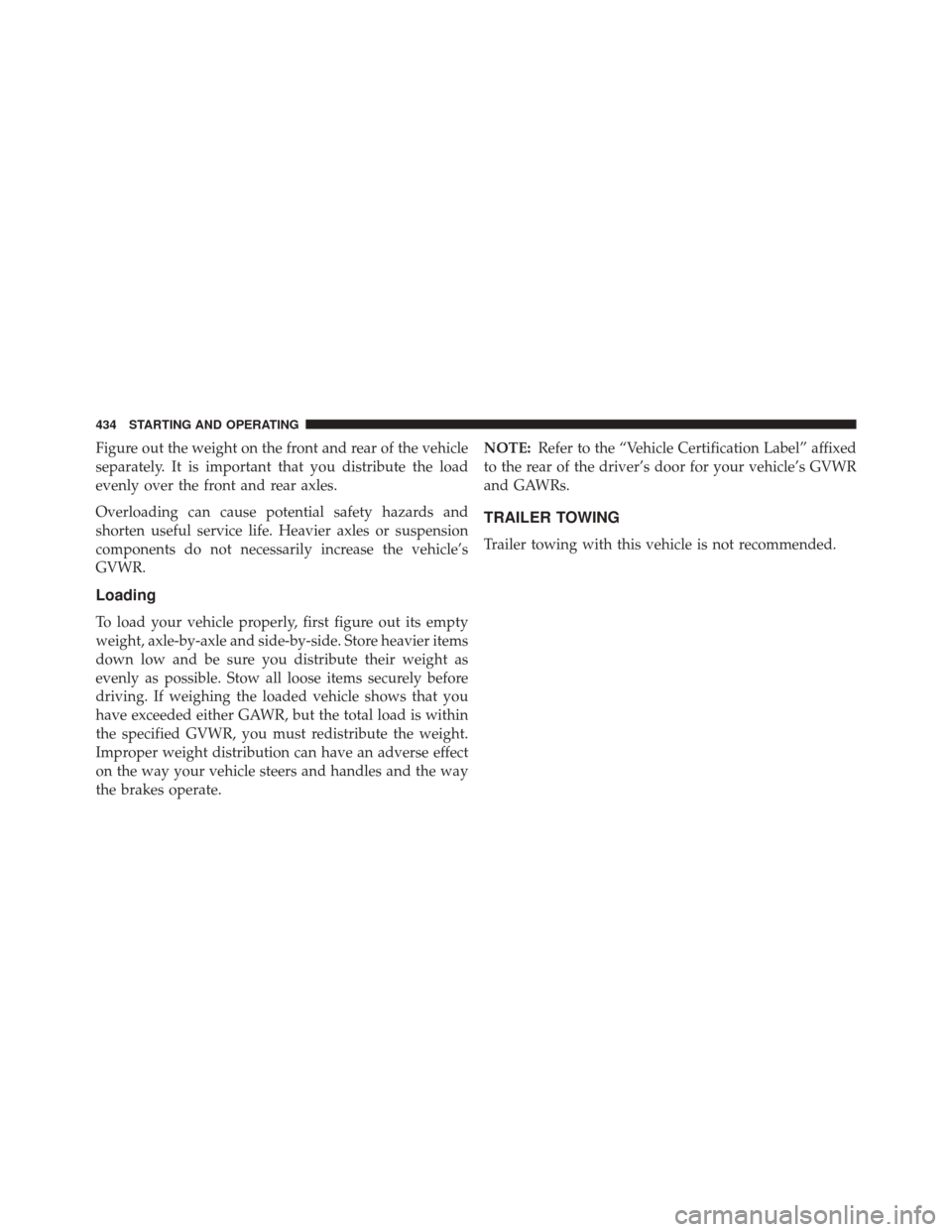
Figure out the weight on the front and rear of the vehicle
separately. It is important that you distribute the load
evenly over the front and rear axles.
Overloading can cause potential safety hazards and
shorten useful service life. Heavier axles or suspension
components do not necessarily increase the vehicle’s
GVWR.
Loading
To load your vehicle properly, first figure out its empty
weight, axle-by-axle and side-by-side. Store heavier items
down low and be sure you distribute their weight as
evenly as possible. Stow all loose items securely before
driving. If weighing the loaded vehicle shows that you
have exceeded either GAWR, but the total load is within
the specified GVWR, you must redistribute the weight.
Improper weight distribution can have an adverse effect
on the way your vehicle steers and handles and the way
the brakes operate.NOTE:
Refer to the “Vehicle Certification Label” affixed
to the rear of the driver’s door for your vehicle’s GVWR
and GAWRs.
TRAILER TOWING
Trailer towing with this vehicle is not recommended.
434 STARTING AND OPERATING
Page 493 of 575
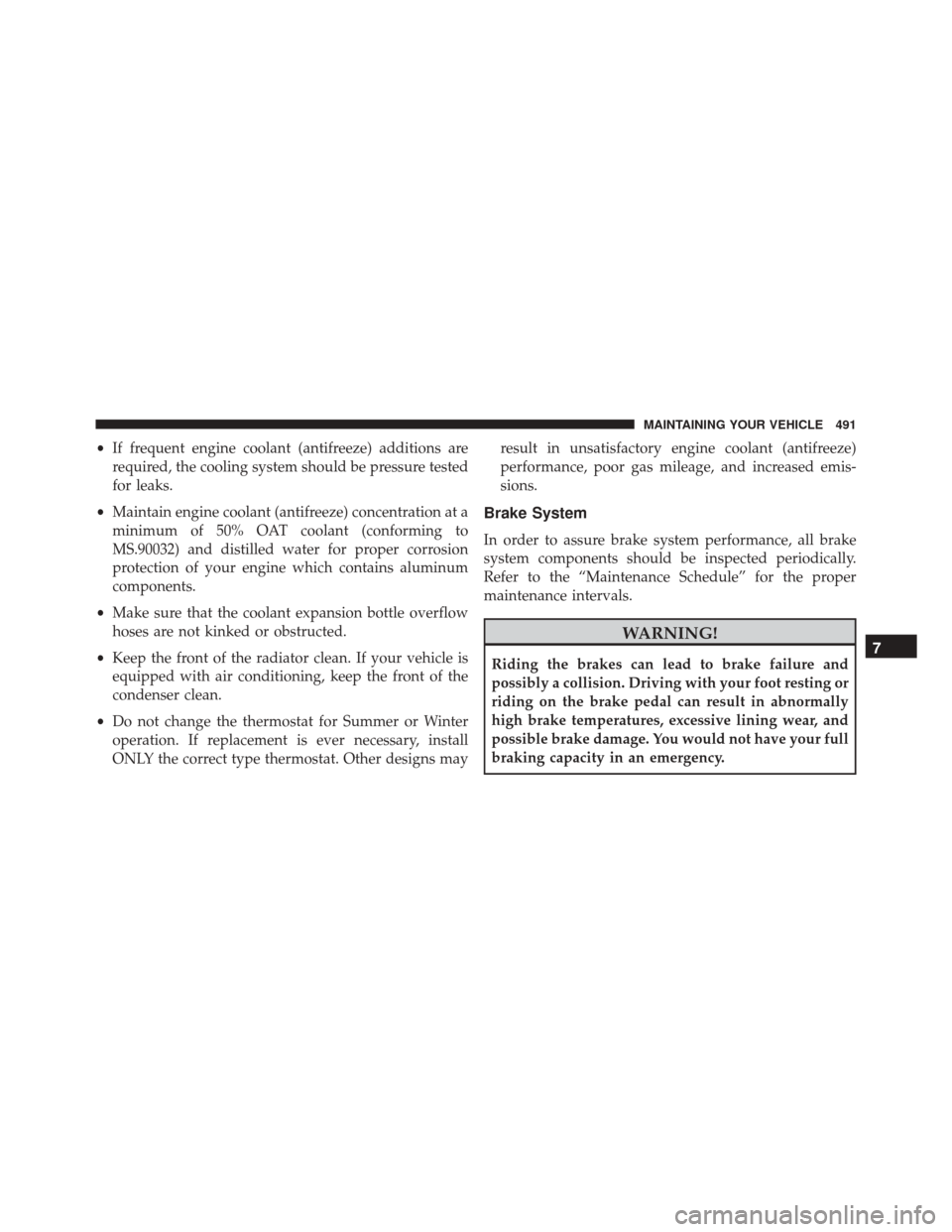
•If frequent engine coolant (antifreeze) additions are
required, the cooling system should be pressure tested
for leaks.
• Maintain engine coolant (antifreeze) concentration at a
minimum of 50% OAT coolant (conforming to
MS.90032) and distilled water for proper corrosion
protection of your engine which contains aluminum
components.
• Make sure that the coolant expansion bottle overflow
hoses are not kinked or obstructed.
• Keep the front of the radiator clean. If your vehicle is
equipped with air conditioning, keep the front of the
condenser clean.
• Do not change the thermostat for Summer or Winter
operation. If replacement is ever necessary, install
ONLY the correct type thermostat. Other designs may result in unsatisfactory engine coolant (antifreeze)
performance, poor gas mileage, and increased emis-
sions.
Brake System
In order to assure brake system performance, all brake
system components should be inspected periodically.
Refer to the “Maintenance Schedule” for the proper
maintenance intervals.
WARNING!
Riding the brakes can lead to brake failure and
possibly a collision. Driving with your foot resting or
riding on the brake pedal can result in abnormally
high brake temperatures, excessive lining wear, and
possible brake damage. You would not have your full
braking capacity in an emergency.
7
MAINTAINING YOUR VEHICLE 491
Page 494 of 575
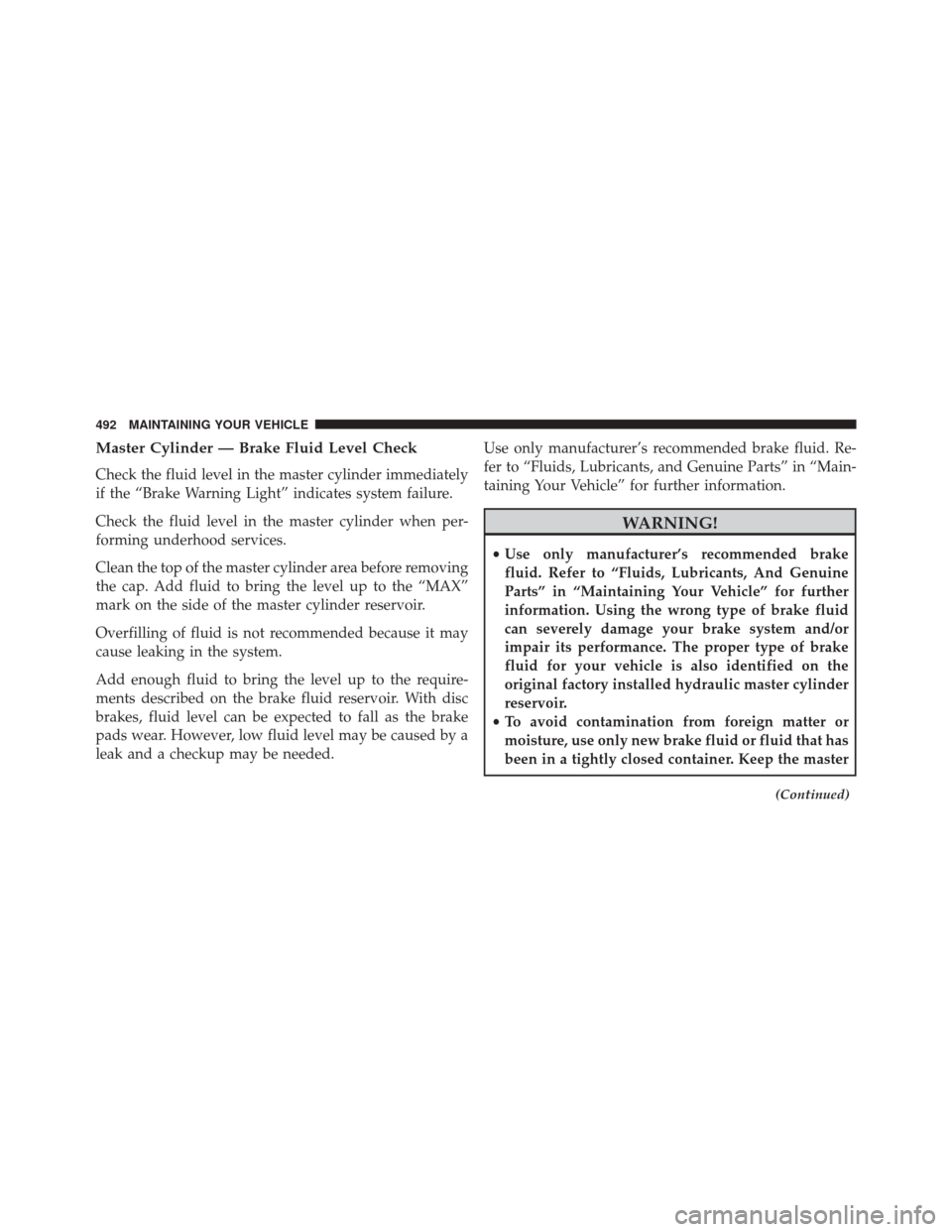
Master Cylinder — Brake Fluid Level Check
Check the fluid level in the master cylinder immediately
if the “Brake Warning Light” indicates system failure.
Check the fluid level in the master cylinder when per-
forming underhood services.
Clean the top of the master cylinder area before removing
the cap. Add fluid to bring the level up to the “MAX”
mark on the side of the master cylinder reservoir.
Overfilling of fluid is not recommended because it may
cause leaking in the system.
Add enough fluid to bring the level up to the require-
ments described on the brake fluid reservoir. With disc
brakes, fluid level can be expected to fall as the brake
pads wear. However, low fluid level may be caused by a
leak and a checkup may be needed.Use only manufacturer’s recommended brake fluid. Re-
fer to “Fluids, Lubricants, and Genuine Parts” in “Main-
taining Your Vehicle” for further information.
WARNING!
•
Use only manufacturer’s recommended brake
fluid. Refer to “Fluids, Lubricants, And Genuine
Parts” in “Maintaining Your Vehicle” for further
information. Using the wrong type of brake fluid
can severely damage your brake system and/or
impair its performance. The proper type of brake
fluid for your vehicle is also identified on the
original factory installed hydraulic master cylinder
reservoir.
• To avoid contamination from foreign matter or
moisture, use only new brake fluid or fluid that has
been in a tightly closed container. Keep the master
(Continued)
492 MAINTAINING YOUR VEHICLE
Page 537 of 575
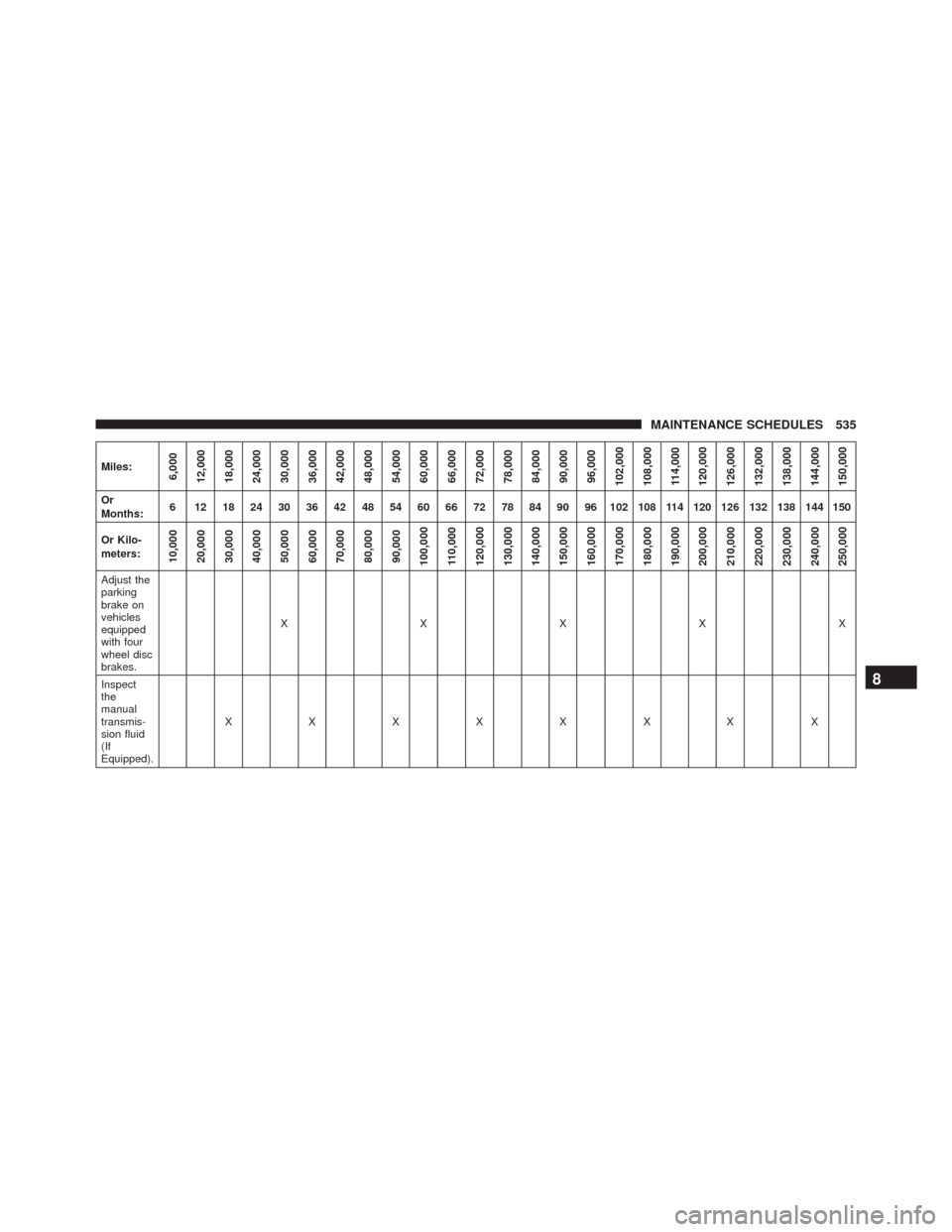
Miles:6,000
12,000
18,000
24,000
30,000
36,000
42,000
48,000
54,000
60,000
66,000
72,000
78,000
84,000
90,000
96,000
102,000
108,000 114,000
120,000
126,000
132,000
138,000
144,000
150,000
Or
Months: 6 12 18 24 30 36 42 48 54 60 66 72 78 84 90 96 102 108 114 120 126 132 138 144 150
Or Kilo-
meters:
10,000
20,000
30,000
40,000
50,000
60,000
70,000
80,000
90,000
100,000
110,000
120,000
130,000
140,000
150,000
160,000
170,000
180,000
190,000
200,000
210,000
220,000
230,000
240,000
250,000
Adjust the
parking
brake on
vehicles
equipped
with four
wheel disc
brakes. XXXXX
Inspect
the
manual
transmis-
sion fluid
(If
Equipped). XXXXXXX X
8
MAINTENANCE SCHEDULES 535
Page 554 of 575
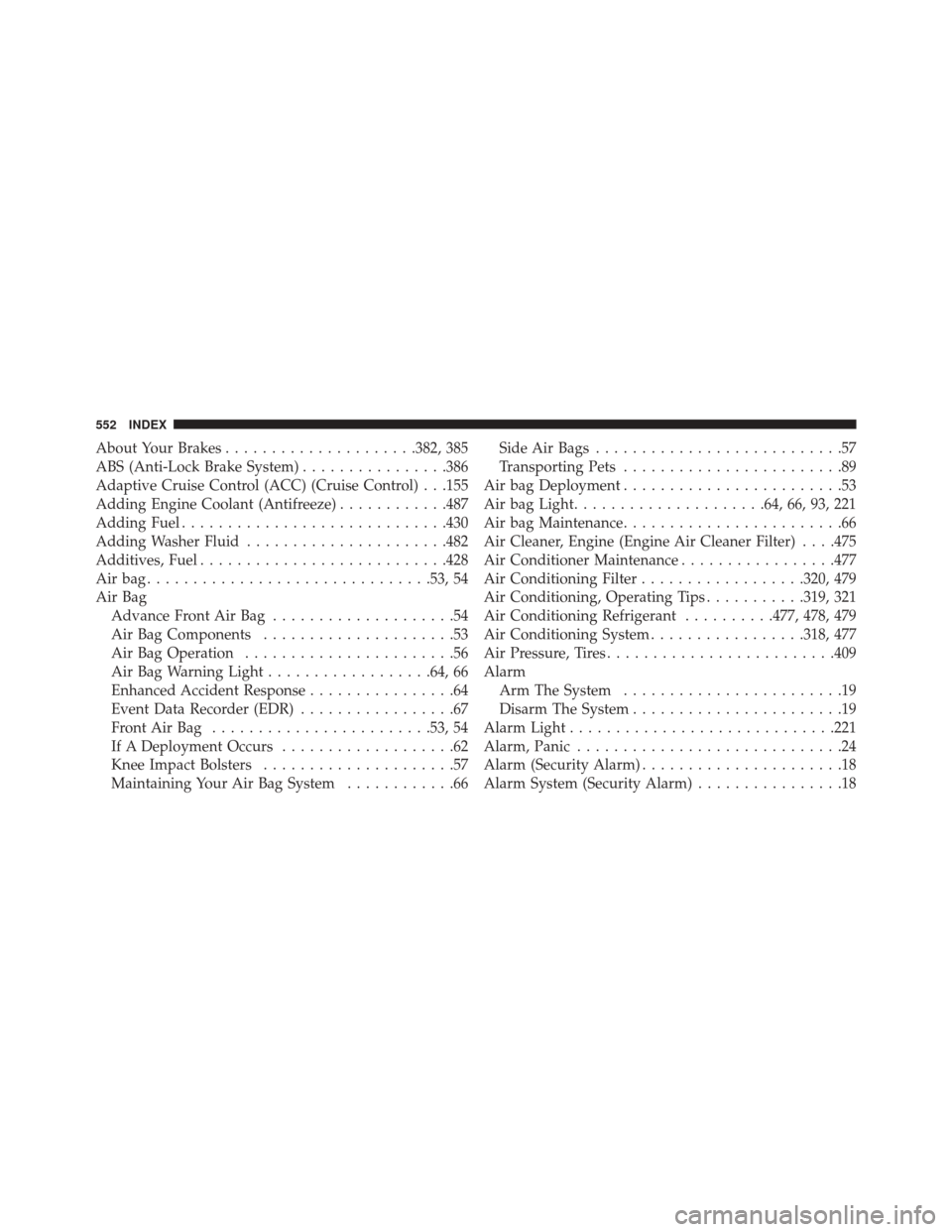
About Your Brakes.....................382, 385
ABS (Anti-Lock Brake System) ................386
Adaptive Cruise Control (ACC) (Cruise Control) . . .155
Adding Engine Coolant (Antifreeze) ............487
Adding Fuel ............................ .430
Adding Washer Fluid ..................... .482
Additives, Fuel .......................... .428
Airbag.............................. .53, 54
Air Bag Advance Front Air Bag ....................54
Air Bag Components .....................53
Air Bag Operation .......................56
Air Bag Warning Light ..................64, 66
Enhanced Accident Response ................64
Event Data Recorder (EDR) .................67
FrontAirBag ........................53, 54
If A Deployment Occurs ...................62
Knee Impact Bolsters .....................57
Maintaining Your Air Bag System ............66Side Air Bags
...........................57
Transporting Pets ........................89
Air bag Deployment ........................53
Air bag Light .....................64, 66, 93, 221
Air bag Maintenance ........................66
Air Cleaner, Engine (Engine Air Cleaner Filter) . . . .475
Air Conditioner Maintenance .................477
Air Conditioning Filter ..................320, 479
Air Conditioning, Operating Tips ...........319, 321
Air Conditioning Refrigerant ..........477, 478, 479
Air Conditioning System .................318, 477
Air Pressure, Tires ........................ .409
Alarm Arm The System ........................19
Disarm The System .......................19
Alarm Light ............................ .221
Alarm, Panic .............................24
Alarm (Security Alarm) ......................18
Alarm System (Security Alarm) ................18
552 INDEX
Page 555 of 575

Alterations/Modifications, Vehicle...............7
Antifreeze (Engine Coolant) ...............486, 522
Disposal ............................. .489
Anti-Lock Brake System (ABS) ................386
Anti-Lock Warning Light .................221, 388
Appearance Care ........................ .496
Arming System (Security Alarm) ...............18
Auto Down Power Windows ..................38
Automatic Door Locks ......................32
Automatic Headlights ..................... .135
Automatic High Beams .....................136
Automatic Temperature Control (ATC) .......310, 318
Automatic Transmission ..............355, 494, 495
Adding Fluid ...................... .495, 525
Autostick ............................ .362
Fluid and Filter Changes ..................495
Fluid Change ......................... .495
Fluid Level Check ...................... .495
Fluid Type ........................... .525Special Additives
...................... .494
Automatic Transmission Limp Home Mode .......361
Autostick .............................. .362
Auto Unlock, Doors ........................32
Axle Fluid ............................. .525
Axle Lubrication ......................... .525
Battery ................................ .476
Keyless Transmitter Replacement (RKE) ........24
Location ............................. .476
Belts, Seat ...............................93
Body Mechanism Lubrication .................481
B-Pillar Location ......................... .403
Brake Assist System ...................... .389
Brake Control System, Electronic ..............386
Brake Fluid ............................ .525
Brake, Parking .......................... .382
Brakes ................................ .385
Brake System ........................ .385,
491
10
INDEX 553